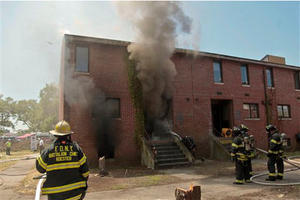First responseFDNY conducts live fire tests to test improvements in fire department tactics
In the name of science, but with aim of saving lives, preventing injuries, and reducing property losses, members of the New York City Fire Department (FDNY) spent much of the first two weeks in July setting fire to twenty abandoned townhouses on Governors Island, about a kilometer from the southern tip of Manhattan

FDNY firefighters drill on a vacant townhouse on Governor's Island // Source: firehouse.com
In the name of science, but with aim of saving lives, preventing injuries, and reducing property losses, members of the New York City Fire Department (FDNY) spent much of the first two weeks in July setting fire to twenty abandoned townhouses on Governors Island, about a kilometer from the southern tip of Manhattan. In a series of “live burn” experiments, conducted in collaboration with the National Institute of Standards and Technology (NIST) and Underwriters Laboratories (UL), New York firefighters challenged the conventional wisdom on, and tested new tactics for, controlling fires and rescuing occupants inside burning homes.
See an FDNY’s video on the Governors Island Ventilation and Suppression Exercise here.
“We studied these fires from start to finish,” explains NIST fire protection engineer Dan Madrzykowski , who led the NIST research contingent at Governors Island. “We turned these row houses into laboratories for real-life experiments that will provide guidance for improving fire-fighting tactics.”
An abandoned Coast Guard barracks built in the 1980s served as the proving ground for so-called positive pressure techniques and other potentially useful ventilation-control and exterior fire suppression methods. The row houses were among structures scheduled for demolition as part of efforts to transform the former Coast Guard regional headquarters into a park and for other civic uses. The townhouses — wood-framed with brick exteriors — were supplied with the same package of sofas, chairs, beds, and other furnishings for the experiments. Each townhouse also was outfitted with about 100 sensors to measure temperatures, heat flows, concentrations of toxic gases and other variables. Cameras were installed inside each row house, as well as in front and back, to monitor and record conditions.
The primary motivation for the live burn experiments are the changing dynamics of fires. The contents of American homes have changed significantly in the past few years. Plastics and other synthetic materials have replaced the natural materials that once made up the bulk of furniture items. In addition, modern living spaces tend to be more open, less compartmentalized.
As a result, interior house fires tend to burn faster and hotter today. The average time to flashover — the extremely perilous phenomenon that occurs when heat builds up in a burning structure’s contents and components to the point that they burst into flames simultaneously — has dropped dramatically since the 1980s.
The experiments evaluated individual and combinations of methods for strategically ventilating and isolating fires to prevent flashover — or at least delay it. In contrast, kicking a door open or breaking a window without knowledge of conditions inside could create a portal for air that can literally fan the flames.
“Fire consumes all the oxygen in a building, and when we ventilate the building, oxygen-induced flashover can occur,” explains Robert Maynes, FDNY deputy assistant chief. “That impacts the safety of our firefighters.”
Information gathered and lessons learned during Governors Island tests will be shared with fire departments throughout the nation. In addition, NIST will use the data to improve the accuracy and improve the capabilities of its widely used fire modeling software.
“These on-the-ground fire tests — in collaboration with FDNY and Underwriters Laboratories — provide a great opportunity for NIST to gather data at full-scale. The data will strengthen the scientific underpinnings of modern fire-fighting tactics and technologies, improve their effectiveness, enhance fire fighter safety, and lead to better building codes and standards,” said Shyam Sunder, the director of NIST’s Engineering Laboratory.
See an overview of the NIST Enhanced Effectiveness of Fire Fighting Tactics Project on the project’s Web site.
